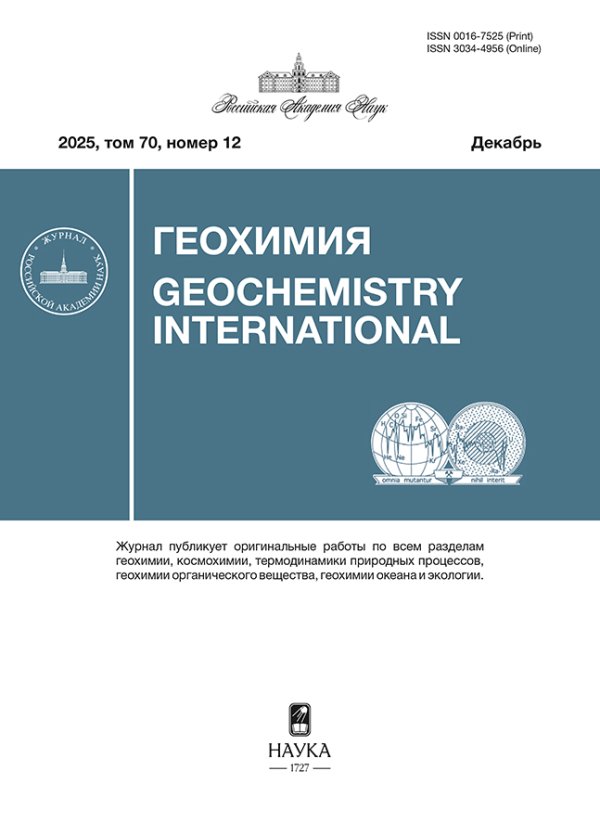Vol 68, No 7 (2023)
Articles
Feldspar Megacrysts as a Source of Information on Crustal Contamination of Basaltic Melt
Abstract
The paper discusses data on the elemental composition and 87Sr/86Sr, and δ18O isotopic ratios of feldspar megacrysts collected from lava flows, tuffs, and cinders of three volcanic fields in the Baikal rift system: Iya–Uda, Vitim, and Khamar-Daban, which are located within the early Precambrian, Riphean, and Paleozoic crustal blocks, respectively. Megacrysts are hosted in trachybasalts in the Iya–Uda and Khamar-Daban fields and in basanites in the Vitim field. Megacrysts belong to the following three compositional groups of minerals: (i) plagioclase in lavas of the Iya–Uda field, (ii) anorthoclase in lava flows, tuffs, and cinders of the Khamar-Daban and Vitim fields, and (iii) sanidine in the Vitim field. Elemental and isotope data suggest that megacrysts crystallized in volcanic chambers at different depth levels: anorthoclase crystallized from the most primitive magma with mantle-derived isotopic signatures at subcrustal depth levels, plagioclases were produced in deep crustal chambers during the interaction between mantle-derived magma and crustal rocks, and sanidine was captured from the upper crustal rocks.
 651-668
651-668


A Stepwise Dissolution Method Applied to Isotopic Chemostratigraphic and Geochronological Studies of Riphean Carbonate Rocks of the Baykit Uplift
Abstract
The potential of the stepwise dissolution analytical procedure to obtain chemostratigraphic and geochronological information is demonstrated by a case study of Riphean carbonate rocks of the Kamovskaya Group of the Baykit Uplift (Eastern Siberia). The procedures suggested for studying Rb–Sr and U–Pb systems in carbonate rocks included (1) selection of samples with the lowest 87Sr/86Sr ratio on the basis of preliminary Rb–Sr analysis of the collection using the routine procedure of bulk leaching in 0.1N CH3COOH; (2) detailed study of the Rb–Sr system in selected samples using two-step dissolution in 0.2N CH3COOH and derivation of L(Rb–Sr)1 and L(Rb–Sr)2 fractions; (3) analysis of Pb isotope composition of the selected samples to derive the preliminary value of their age; (4) detailed study of U–Pb system of carbonate rocks using the stepwise dissolution in 0.5N HBr, resulting in six dissolved fractions L(U–Pb)1–L(U–Pb)6 for each of the selected samples; and (5) a final calculation of the Pb–Pb age of the studied rocks, based on the results from the obtained fractions, with the exclusion from the calculation of the initial fractions of this dissolution containing epigenetically altered carbonate material. The values of the primary 87Sr/86Sr ratio in L(Rb–Sr)2 fractions of carbonate rocks of the Kamovskaya Group are as follows: limestone of the Madrinskaya Formation, 0.70490; dolomites of the Yurubchenskaya Formation, 0.70495–0.70503; and dolomites of the Kuyumbinskaya and Vingoldinskaya formations, 0.70580 and 0.70521, respectively. These values characterizing the least altered carbonate material correspond to 87Sr/86Sr ratios in the Early Archean and can be used for chemostratigraphic calculations. Taking into account the Rb–Sr data, the U–Pb age of the Yurubchenskaya Formation carbonate rocks dissolved in six steps was calculated, starting from L(U–Pb)3. The slope of the resulting isochron in the coordinates 206Pb/204Pb–207Pb/204Pb corresponds to 1501 ± 23 Ma, which supports the conclusion that the carbonate rocks of the lower part of the Kamovskaya Group of the Baykit Uplift were formed in the Early Riphean.
 669-686
669-686


On the Formation of Diasteranes in Oil and Organic Matter of Rocks
Abstract
Data obtained on the distribution patterns of biomarker hydrocarbons (n-alkanes, isoprenanes, steranes, and terpanes) in oils, organic matter in rocks, prokaryotes, and thermolysis products of the insoluble part of prokaryotic biomass indicate that the relatively high concentration of diasteranes (rearranged steranes) in the organic matter of rocks and in oils generated by clay strata is caused by characteristics of the original organic matter but not by the process of isomerization of regular steranes, as has been previously thought.
 687-694
687-694


Conversion of the Oil and Gas Generation Potential of the Deep Source Formations of the West Siberian Basin: An Example of Well Tyumen SG-6
Abstract
A model of the thermal evolution of the lithosphere of the West Siberian Basin in the area of Superdeep Well SG-6, which was drilled through the Koltogor–Urengoi graben, is used to numerically estimate the generation of various hydrocarbon (HC) fractions by the Triassic and Jurassic source rocks. The thermal model assumes the emplacement of a sill into the subsurface layers of the basement in the Early Jurassic and hydrothermal activity in the Late Pliocene–Lower Pleistocene, which noticeably impacted the conversion history of the HC potential of the Triassic and Jurassic source rocks. For the Triassic Pur formation, the emplacement of the sill into the subsurface layers of the basement in the Lower Jurassic drastically intensified the conversion of the HC potential to 84% and the degradation of more than 97% of the generated light oil mass. Calculations show that the heavy oil generated by the rocks of the Pur, Togur, and lower horizons of the Tyumen formations has degraded almost completely as a result of secondary cracking, while heavy oil predominates among the generated HC fractions in the upper horizons of the Tyumen Formation and in the rocks of the Bazhenovo Formation. The light oil remaining nowadays in the matrix of the source rocks has completely degraded in the Triassic rocks but makes up much of the HC products in rocks at the bottom of the Togur Formation and the top of the Tyumen Formation. This oil is the dominant in the upper horizons of the Togur Formation and in the bottom part of the Tyumen Formation. According to calculations, gas hydrocarbons account for a significant proportion of HC products in the Togur and Tyumen formations, and they dominate in the Middle Triassic Pur Formation. At the relatively low initial potential of HC generation and a low content of organic matter in the rocks of the Pur, Togur, and Tyumen formations, no primary expulsion threshold of liquid HC has been reached, and the generated liquid HC probably did not leave the rock matrix, while the gaseous HC likely migrated. The threshold of primary expulsion of liquid HC for the Bazhenov rocks was calculated to be reached at about 65 My.
 695-708
695-708


Heavy Metals and Organic Carbon in the Bottom Sediments of Shallow Bights of the Peter the Great Bay
Abstract
A noticeable feature of labile heavy metals is that they are highly prone to be to bioaccumulated and bioassimilated in natural environments. When in high concentrations, these metals are toxic to living organisms, as is particularly evident in the coastal shallow marine zones, which are most strongly affected by anthropogenic processes. This paper presents data on the contents of heavy metals, concentrations of organic carbon, and the granulometric composition of bottom-sediment cores in three shallow bights of the Peter the Great Bay, in two of which (Voevoda and Novgorodskaya bights), large bottom areas are overgrown with seagrass Zostera marina L. (sea zostera, ZM). Data on the vertical distribution of heavy metals and organic carbon in the cores showed that the highest concentrations of Zn and Cu (up to 204 and 91 mg/kg, respectively) occur in samples from Voevoda bight, and the highest concentrations of Mn and Pb (up to 344 and 45 mg/kg, respectively) were found in Novgorodskaya bight, where meadows of the seagrass grow. The highest Cr, Ni, and Co contents (up to 69, 31, and 13 mg/kg, respectively) were identified in Uglovoy bight, where sea grass is practically absent.
 709-719
709-719


SODALITE: SPECTROSCOPIC AND THERMOCHEMICAL INVESTIGATIONS
Abstract
Two sodalite samples (sample I is Na8Al6Si6O24Cl2⋅0.4H2O from the Kovdor alkaline ultramafic massif with carbonatites in the Murmansk region, Russia, and sample II is Na8Al6Si6O24Cl2⋅0.2H2O from the Bayan Kol nepheline syenite and miaskite massif in the Republic of Tyva) were studied by thermal and electron-microprobe analyses, powder X-ray diffraction, photoluminescence, and by IR, Raman, and ESR spectroscopy. Solution melt calorimetry was applied to determine the enthalpy of formation from elements for water-bearing sodalite samples: −13536 ± 10 (I) and −13503 ± 19 (II) kJ/mol. The enthalpy of formation of sodalite of the theoretical composition Na8Al6Si6O24Cl2 was evaluated at ΔfH0(298.15 K) = −13446 ± 11 kJ/mol. The data obtained on the enthalpy of formation of sodalite and literature data on its S0(298.15 K) were used to calculate the standard Gibbs energies of formation of anhydrous and of water-bearing sodalite.
 720-729
720-729


Microwave Preparation of Geological Samples in UltraWAVE System for the Determination of Platinum Group Elements and Rhenium by Mass-Spectrometric Isotope Dilution
Abstract
We report the first results of the application of UltraWAVE reactor-type microwave system for geological sample preparation (T = 250°C and P up to 80 bar) with a mixture of concentrated nitric and hydrochloric acids (3 : 1). Determination of the platinum group elements – Ru, Pd, Ir, Pt (PGE) and Re after acid digestion was carried out by isotope dilution using the high-resolution mass-spectrometer ELEMENT after chromatographic separation of analytes on an AG50Wx8 cation exchange resin. The monoisotopic rhodium was determined with 195Pt as an internal standard. The achieved detection limits were from 0.003 ng/g (Ir) to 0.09 ng/g (Pt). The correctness of the new procedure was confirmed by the analysis of geological reference samples—GP-13, UB-N, BHVO-2. The proposed procedure significantly accelerates and simplifies the preparation of geological samples for PGE and Re determination compared to the Carius tube technique.
 730-736
730-736


Modeling and Predicting the Environment State in the Impact Area of a Copper–Nickel Plant: A Balanced Model of the Transformations of Atmospheric Deposition at the Catchment and in Lake
Abstract
The paper discusses modeling the dynamics of nickel concentration in soils, water, and the bottom sediments of lakes caused by atmospheric emissions from the Pechenganickel plant, Kola Peninsula, throughout its whole operation period. The applied technology of balanced identification makes it possible to use a mathematical description of heterogeneous geochemical processes in ecosystems to combine heterogeneous experimental data and build up a computer model with an optimal balance of its complexity and fitting quality of the data. The model is used to analyze the spatial and temporal variability of natural objects in the zone of distribution of atmospheric pollution (nickel) from the Pechenganickel plant. The paper presents and discusses results of this study, including estimates of the retrospective state of the simulated objects (before the start of the intense studies) and a forecast of their dynamics until 2030. According to the model calculations, the intensity of Ni accumulation in the soil and bottom sediments was 2.35 and 4.48 mg/(m2 year) during the maximum deposition periods (1980–2005), whereas the model predicts a decrease in the intensity of Ni accumulation in the bottom sediments (0.23 mg/(m2 year)) and slow Ni leaching from the soil (0.19 mg/(m2 year)) after the shutdown of the plant.
 737-749
737-749


Двадцать третья международная конференция “Физико-химические и петрофизические исследования в науках о Земле”
 750-754
750-754












